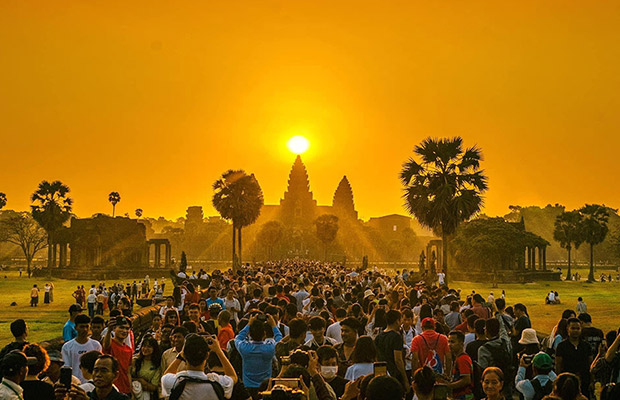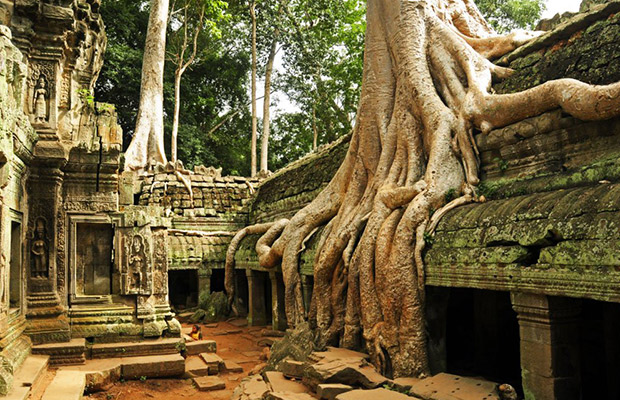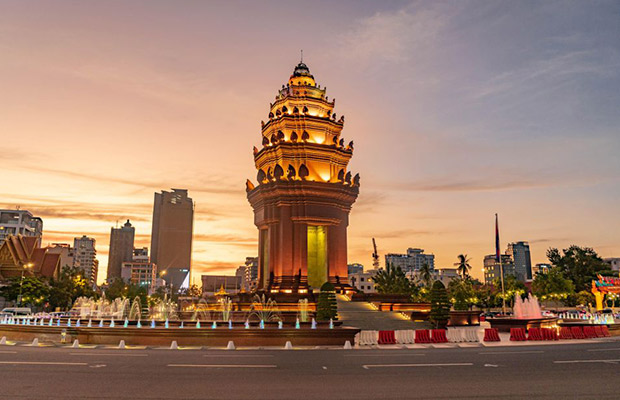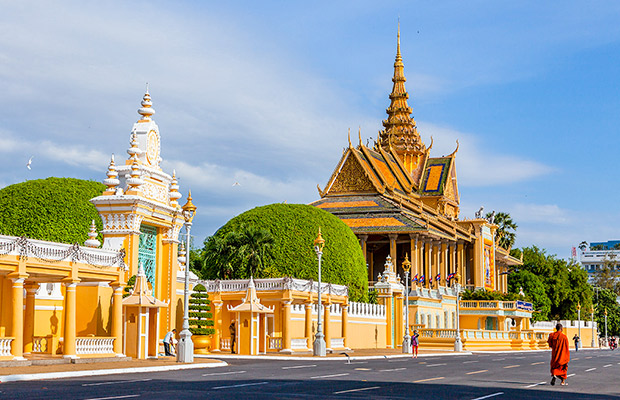








$520 $499
6 Days
Siem Reap
English
Included
Up to 48 hours
Make the most of your time in Cambodia on a private tour. Relax and enjoy your vacation without the hassle of planning the logistics. This six-day tour focuses on Siem Reap (gateway to Angkor Wat) and the capital, Phnom Penh. Learn all about Cambodian history, from the ancient Angkor empire to the dark Khmer Rouge period. Stay in comfortable four or five-star accommodation along the way.

From Siem Reap City
Our professional tour guide and driver, they are waiting to welcome you and transfer you to city Siem Reap before go to hotel for check in and they will provide you more information about city with daily life of the people in the city and arrival at the hotel free time leisure . Overnight in Siem Reap.
Angkor Wat Get up early at 04 : 30 AM and transfer to visit the most amazing sunrise at Angkor Wat temple and after sunrise continue to explore the Angkor Wat complex and after that transfer back to hotel for breakfast and after that transfer back to explore the Angkor ancient city of the world heritage site of UNESCO.
Angkor Thom South Gate The south gate of Angkor Thom is most popular with visitors, as it has been fully restored and many of the heads remain in place. The gate is on the main road into Angkor Thom from Angkor Wat.
Bayon Temple The Bayon temple was built nearly 100 years after Angkor Wat. The basic structure and earliest part of the temple ate not known. Since it was located at the Centre of a royal city it seems possible that the Bayon would have originally been a temple-mountain conforming to the symbolism of a microcosm of Mount Meru. The middle part of the temple was extended during the second phase of building. The Bayon of today belong to the third and last phase of the art style. The Smiling Face at Bayon, the architectural scale and composition of the Bayon exude grandness in every aspects. Its elements juxtapose each other to create balance and harmony and there are more then 200 large faces carved on the 54 tower give this temple its majestic character.
Angkor Thom was the capital city of the Khmer Empire , Angkor Thom is undeniably an expression of the highest genius. It is, in three dimensions and on a scale worthy of an entire nation, the materialization of Buddhist cosmology, representing ideas that only great painters would dare to portray.
Baphoun is the temple stands on a rectangular sandstone base with five levels that are approximately the same size, rather than the more common form of successively smaller levels. The first, second and third levels are surrounded by sandstone galleries. Baphuon is the first structure in which stone galleries with a central tower appear. Two libraries in the shape of a cross with four porches stand in the courtyard. They were originally connected by an elevated walkway supported by columns.
Phimeanakas temple is situated near the center of the area enclosed by the walls of the Royal Palace. It must originally have been crowned with a golden pinnacle, as Zhou Daguan described it as the Tower of Gold The temple is built of roughly hewn sandstone blocks and has little decoration.
Terrace of the Elephants The elephants are ridden by servants and princes, and tread as quietly as if they were on an excursive promenade. The steps of even length have no respect for any obstacle. The forest in which they travel in impenetrable to all but tiny creatures, able to squeeze their smallness between the fissures of the undergrowth and to the biggest animals, which crush chasms for their passage in the virgin vegetation.
The terrace of the Leper King carries on the theme of grandeur that characterizes the building during Jayavarman VII’s reign. It is faced with dramatic bas-reliefs, both on the interior and exterior. During clearing, the EFEO found a second wall with bas-relief similar in composition to those of the outer wall and some archaeologists believe that this second wall is evidence of a late rites, two meters wide of laterite faced with sandstone. It collapsed and a second wall of the materials, two meters wide, was built right in front of it without any of the rubble being cleared. Recently, the EFEO has created a false corridor which allows visitor to inspect the relief on the first wall
Ta Nei Temple This small temple is located deep in the Cambodian jungle, about 200 meters west of the East Baray. It can be difficult to find, and it is not a popular tourist destination. Because of the temple’s obscurity, a visit to Ta Nei can be quite rewarding for the adventurous traveler. The handful of wanderers that visit Ta Nei are not hassled by peddlers, or interrupted by the voices of excited travelers. The temple rewards them with the same charm that affected the early Angkor explorers. Ta Nei was built late in the 12th century. King Jayavarman VII is responsible for the design and construction of the temple. He dedicated the stone monument to the principles of Buddhism.
Ta Prohm Temple is the undisputed capital of the kingdom of the Trees. It has been left untouched by archaeologists except for the clearing of a path for visitors and structural strengthening to stave of further deterioration. Because of its natural state, it is possible to experience at this temple the wonder of the early explorers when they came upon these monuments in the middle of the nineteenth century. Shrouded in dense jungle the temple of Ta Prohm is ethereal in aspect and conjures up a romantic aura. Fig, banyan and kapok trees spread their gigantic roots over stones, probing walls and terraces apart, as their branches and leaves intertwine to form a roof over the structures. Trunks of trees twist amongst stone pillars. The strange, haunted charm of the place entwines itself about you as you go, as inescapably as the roots have wound themselves about the walls and towers.
Banteay Samre is one of the most complete complexes at Angkor due to restoration using the method of anastomosis. Unfortunately, the absence of maintenance over the past 20 years is evident. The name Samre refers to an ethnic group of mountain people, who inhabited the regions at the base of Phnom Kulen and were probably related to the Khmers.
Banteay Srey is the unanimous opinion among French archaeologists who worked at Angkor is that Banteay Srei is a ‘precious gem’ and a ‘jewel in Khmer art’. Banteay Srei, as it is known by locals and it was originally called Isvarapura, according to inscriptions. It was by a Brahmin of royal descent who was spiritual teacher to Jayavarman V. Some describe, it is a being closer in architecture and decoration to Indian models than any other temple at Angkor. A special feature of the exquisite decoration was the use of a hard pink sandstone (quartz arenite) where enabled the technique of sandalwood carving with even an Indian scent to it.
Preah Khan temple is located 2 kilometers north-east of Angkor Thorn on the Grand Circuit. The temple was built in the second half of the 12th century in AD 1191 by King Jaya-varman VII, dedicating to his father Dharanindravarman. The Buddhist complex covers 56 hectares served as the nucleus of a group of Angkor complex.
Neak Pean is one of the temples that make one dream of the olden days of luxury and beauty, it is a large square man made pond ( 70 meters, 230 feet each side ) bordered by steps and surrounded by four smaller ponds. A small circular island with a stepped base of seven laterite tiers is in the center of the large square pond. Small elephants sculpted in the round originally stood on the four comers. The central tower was dedicated to Avalokitesvara.
Ta Som has not been restored. It is a small quiet temple and affords a delightful visit. In the past one of the significant features of Ta Som was the growth of fig trees the faces at the entrance towers. These have been cut from the east tower but they are still visible at the west one. Ta Som is a single tower monument on one level surrounded by three enclosing walls with entry on the east and west carved with four faces, the face on the right of the east tower (facing the temple) has a beautiful smile. The entry towers are in the shape of a cross with a small room on each side connecting to a laterite wall.
Pre Rup is superb of boldness of the architectural design and give the temple fine balance, scale and proportion. The temple is almost identical in style to the East Mebon, although it was built several years later. It is the last real temple mountain. Pre Rup was called the ‘City of the East ‘ by Philippe Stern, a Frenchman who worked on the site but the Cambodians have always regarded this temple as having funerary associations but reason is unknown. The name Pre Rup recalls one of the rituals of cremation in which the silhouette of the body of the deceased, outlined with its ashes, is successively represented according to different orientations, Some archaeologists believe that the large vat located at the base of the east stairway to the central area was used at cremations.
Phnom Bakheng is the place from which you can witness the sunset, from the top you can see the Angkor Wat temple in the middle of the jungle 1 hour
Spean Praptos
Kampong Kdei Bridge, also known as the Dragon Bridge or Spean Praptos, locates in Siem Reap province and has a life expectancy of over 1000 years. It is said to be the oldest laterite bridge in Southeast Asia and the oldest bridge in Cambodia and worth a visit during your trip in Cambodia.
Stone Statue
Shop Road You will see many shops selling stone statues along this road. Their work is amazing. Some of their work is really big because it’s designed to be delicates to Buddhist temples. After the road has been paved, they started to make bigger statues. They also sell small ones if you would like to have it for yourself.
Skun Spider Sanctuary Skun, it is the Cambodian town of Skun host one of the most unusual markets in the world. At first sight, it looks like any other market in Asia, but it does focus on a product you won’t find in many other places. Skun market has become a world famous tourist attraction, due to the fried spider snacks that are so popular here. Among all the fruit and vegetable stands, you’ll see women carrying large trays, full of fried and spiced spiders, some the size of a grown man’s palm. Spiders are eaten in various areas.
Phnom Penh
Phnom Penh, Cambodia’s busy capital, sits at the junction of the Mekong and Tonlé Sap rivers. It was a hub for both the Khmer Empire and French colonialists. On its walkable riverfront, lined with parks, restaurants and bars, are the ornate Royal Palace, Silver Pagoda and the National Museum, displaying artifacts from around the country. At the city’s heart is the massive, art deco Central Market.
Royal Palace
The Royal Palace is one of Phnom Penh’s most iconic landmarks. The construction began in 1886 after King Norodom relocated the royal capital to Phnom Penh and was completed before World War I. Up until today, the palace is the primary residence of The King of Cambodia. While parts of the palace with its golden roofs are closed to the public others like the elegant Throne Hall can be visited. Topped by a 59m-high tower that was inspired by the Bayon in Angkor Thom, the Throne Hall is used for coronations and other ceremonies. Besides the Throne Hall, visitors may also visit the graceful open-air Chan Chaya Pavilion, also called Dancing Pavilion. It was formerly used for classical Khmer dance performances.
Silver Pagoda
The beautiful Silver Pagoda is located next to the Royal Palace in Phnom Penh. With its beautiful garden, it is a perfect get away from the busy streets of Cambodia’s capital. The inside of the pagoda is equally stunning as countless handcrafted silver tiles are covering the floor. The pagoda is also known as the Temple of the Emerald Buddha because the primary Buddha statue is made of emerald or baccarat crystal. The other Buddha is a golden life-sized Buddha Maitreya which is also known as the Buddha of the Future. The statue is made of 90kg pure gold and is adorned with over 2,000 diamonds, including a 25-carat diamond in the crown as well as a 20-carat diamond in the chest. There is also an eye-catching bronze statue, featuring the late King Norodom.
Wat Phnom
Wat Phnom : Set on top of a tree-covered knoll 27m high, Wat Phnom is the only hill in town. According to legend, the first pagoda on this site was erected in 1373 to house four statues of Buddha deposited here by the waters of the Mekong and discovered by a woman name Penh. The main entrance to Wat Phnom is via the grand eastern staircase, which is guarded by lions and naga (snake) balustrades.
Independence Monument
The Independence Monument in Phnom Penh, capital of Cambodia, was built in 1958 to memorialize Cambodia’s independence from France in 1953. It stands on the intersection of Norodom Boulevard and Sihanouk Boulevard in the centre of the city. It is in the form of a lotus-shaped stupa, of the style seen at the Khmer temple at Banteay Srei and other Khmer historical sites. The Independence Monument was designed by the Cambodian architect Vann Molyvann. It stands 37 meters tall. During national celebrations, The Independence Monument is the center of activity. A ceremonial flame on the interior pedestal is often lit by a royal or high official on these occasions, and floral tributes line the stairs. Every year, The Independence Monument is visited by foreign tourists and locals alike. Behind the monument is the Norodom Sihanouk Memorial, constructed in 2013.
Wat Ounalom
Wat Ounalom is another of Phnom Penh’s five original monasteries (1422). it housed the Institute Bouddhique and library. On the riverfront about 250 meters north of the Royal Palace, facing the Tonle Sap River near the Royal Palace, this pagoda serves as the headquarters for one of Cambodia‘s most revered Buddhist patriarchs . Ounalom Pagoda, Phnom Penh is one of the major tourist attractions in Phnom Penh. With respect to the numerous pagodas, parks, monuments and museums, the city of Phnom Penh in Cambodia is an idea destination for the vacationers. A visit to the Ounalom Pagoda, Phnom Penh will render a pleasurable experience to your trip to this city.
Tuol Sleng Genocide Museum
Tuol Sleng Genocide Museum is a museum in Phnom Penh, the capital of Cambodia, chronicling the Cambodian genocide. The site is a former secondary school which was used as Security Prison 21 (S-21) by the Khmer Rouge regime from its rise to power in 1975 to its fall in 1979. From 1976 to 1979, an estimated 20,000 people were imprisoned at Tuol Sleng (the real number is unknown). Tuol Sleng means “Hill of the Poisonous Trees” or “Strychnine Hill”. Tuol Sleng was just one of at least 150 torture and execution centers established by the Khmer Rouge though other sources put the figure at 196 prison centers. On July 26, 2010, the Extraordinary Chambers in the Courts of Cambodia convicted the chief of Tuol Sleng Prison, Kang Kek Iew, (alias Duch) for crimes against humanity and grave breaches of the 1949 Geneva Conventions and sentenced him to life imprisonment
Choeung Ek Genocidal Center
Choeung Ek is the site of a former orchard and mass grave of victims of the Khmer Rouge killed between 1975 and 1979 about 17 kilometers south of Phnom Penh, Cambodia. It is the best-known of the sites known as The Killing Fields, where the Khmer Rouge regime executed over one million people between 1975 and 1979. Mass graves containing 8,895 bodies were discovered at Choeung Ek after the fall of the Khmer Rouge regime. Many of the dead were former political prisoners who were kept by the Khmer Rouge in their Tuol Sleng detention center and in other Cambodian detention centers. Today, Choeung Ek is a memorial, marked by a Buddhist stupa. The stupa has acrylic glass sides and is filled with more than 5,000 human skulls.
Central Market
The Central Market is a large market constructed in 1937 in the shape of a dome with four arms branching out into vast hallways with countless stalls of goods. Initial designed by Jean Desbois (1891 Cherbourg -1971 Lorient). Construction works were supervised by French architect Louis Chauchon (1875 – 1945 Saigon) and the ingénue Wladimir Kandaouroff. It is located in Cambodia’s capital city, Phnom Penh. When it first opened in 1937, it was said to be the biggest market in Asia; today it still operates as a market. From 2009 to 2011, it underwent a US$4.2 million renovation funded by the French Development Agency. The unique Art Deco building is a Phnom Penh landmark.
Statue of King Father Norodom Sihanouk
The Norodom Sihanouk Memorial, also called the Statue of King Father Norodom Sihanouk, is a monument commemorating former King Norodom Sihanouk located in Phnom Penh, Cambodia. The bronze statue is 4.5 meters tall and is housed under a 27 meter high stupa in the park east of the Independence Monument.
Phnom Penh International Airport On the morning after breakfast in hotel free time leisure until transfer ( without Guide ) from your hotel to Phnom Penh International airport and say goodbye Cambodia.
Pickup point
Pickup details
We offer free pick up from Siem Reap Angkor International Airport on the first day of the arrival date and private transfer to your hotel in Siem Reap, please provide us your arrival information detail as Airline company, Flight Number, Arrival time at Siem Reap International Airport that our diver will pick you up and transfer you to hotel.
In case have any change or cancel booking must be informed in advance at least 48 hours, under 24 hours charge 50%, No show charge 100%.
© 2024, Angkor Discovery Tours. All Rights Reserved.
Our team of passionate guides are here would love to hear from you.

6-Day The Best of Cambodia Private Tours